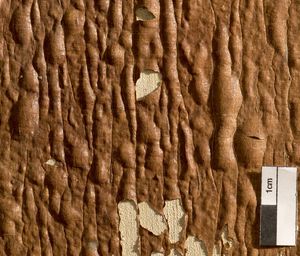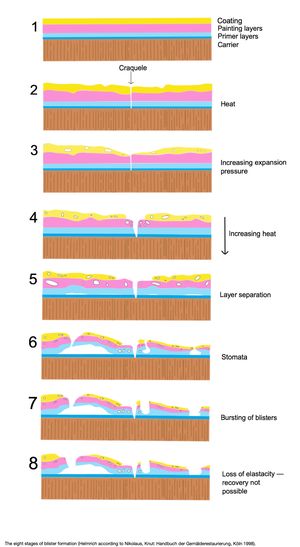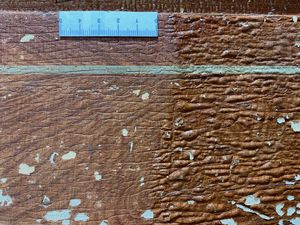Hochschularbeit
| Carla Helmrich: | Consolidation of heat blisters in relation to a ainted door of the wooden interior of the uppertsberg teahouse | Zurück |
| Sprache: | Original - Übersetzung | |
| Seitenübersicht: |
|
|
 Overall view of the door T1, rebate side, Pre-state.
|
|
 Close up of the heat blisters linked to each other by outlets and visible stomata.
|
|
| Zusammenfassung: | This bachelor thesis deals with the formation of heat blisters and the chemical and physical processes involved. Using a fire-damaged, painted door of the Ruppertsberg Teahouse (1842), a concept is developed for flattening and consolidating the heat blisters. In doing so, the focus is on the subsequent reuse of the door. First, common methods of heat blister treatments known in restoration practice are presented, in a next step, their suitability for the object in question is weighed up and finally three heat sources are tested. The research process shows, that the use of an infrared lamp in combination with a heating spatula can be used to make the blisters more flexible and thus lay them down. An acrylic (Plexigum PQ611) dissolved in solvent is used to sufficiently consolidate the paint layers. |
| Schlagworte: | Heat damage, fire blisters, heat blisters, autoxypolymerization, oil-based, pyrolysis, layer separation, Teahouse Ruppertsberg, blister treatment, acrylic resin, heating spatula |
 The eight stages of blisters formation (Helmrich according to Nicolaus, Knut: Handbuch der Gemälderestaurierung, Köln 1998).
|
|
 Blister surface after flattening and consolidating.
|
|
| weitere Angaben: |
|
| Kontakt: |
Carla Helmrich carla@[Diesen Teil loeschen]helmrichs.de |
| Zurück | |
Das Hornemann Institut verfügt ausschließlich über die hier angezeigten Informationen. Für weitere Informationen oder Kopien der Hochschularbeit wenden Sie sich bitte an den Autor/die Autorin - oder wenn kein Kontakt angegeben ist - an die Sekretariate der jeweiligen Fakultäten.